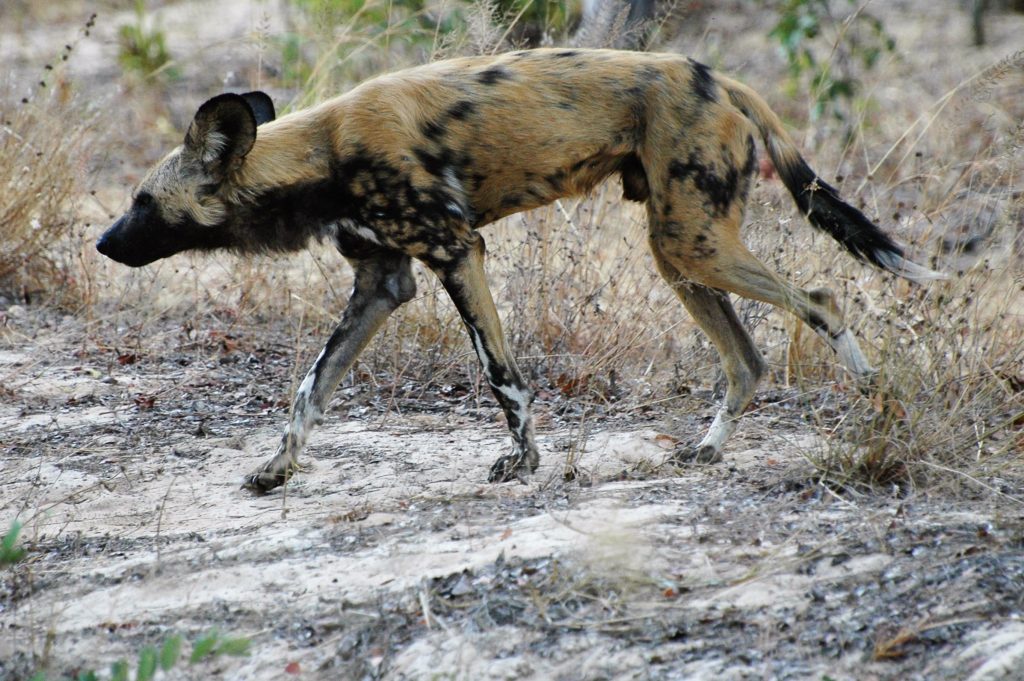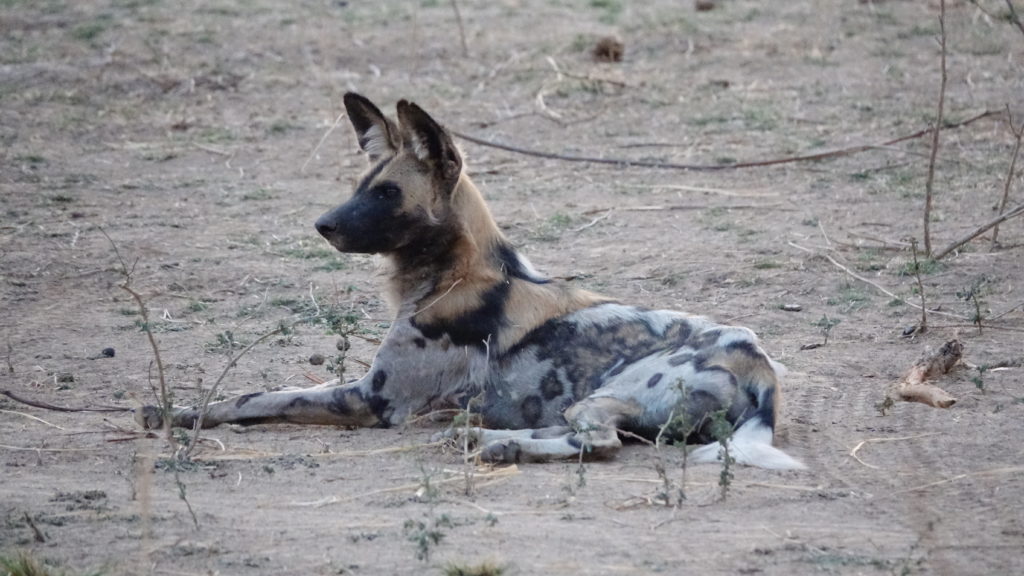Home » Species in Peril » AFRICAN WILD DOG
Species in Peril:
Painted Wolves

Large, rounded, erect ears create an acute sense of hearing
No two wild dogs have the same markings, like a fingerprint.
Wild dogs have only four toes on each foot, unlike domestic dogs.
African Wild Dogs in the Land of Lions
Unique Physique
Their scientific name, Lycaon pictus, literally means painted wolf, referencing their mottled fur with black, brown, yellow and white colourings. Every individual’s coat has a unique pattern, which helps with identification. They have an extremely powerful bite – with specialised molars for shearing meat and breaking bone – and exceptionally keen senses of sight, smell and particularly hearing. Large rounded ears lined with numerous muscles allow them to swivel like radar dishes, picking up the minutest of sounds.
African wild dogs are not actually part of the normal dog family at all, as they have some very distinct differences. For instance, they have 4 toes per foot, not 5 like domesticated dogs. Although they share a common ancestor with wolves and are distantly related to dogs, they absolutely cannot be domesticated as it is not in their genetic framework.
They Can't Be Domesticated
People have attempted to tame painted wolves, but never successfully. They are naturally distrusting of humans or indeed any animal outside of their own pack. When humans have domesticated dogs in the past, it was due to certain character traits prevalent in canines that could be amplified through breeding. One of these traits was a willingness to be touched by humans. But painted wolves have never displayed these traits and it is unlikely they ever will.
Interesting Genetics
Painted wolves used to be found across the African continent, but are now limited to countries in the south and east of Africa, the main strongholds being in Botswana’s Okavango Delta and the Tanzania’s Selous Game Reserve. East African painted wolves are slightly smaller than their counterparts in the south. There are five subspecies of painted wolf; the Cape, East African, West African, Chadian and Somali, though the genetic diversity of these subdivisions is under debate. Although painted wolves do share a common ancestor with wolves from a few million years ago, they are not genetically compatible, so interbreeding with any other canids isn’t possible. The selective breeding applied to domesticated dogs which formed the different breeds could never work with painted wolves.
Relationship Values
The dominant pair is monogamous and would usually be the only ones in the pack to breed, though a beta pair does sometimes produce pups as well, which are then either killed or adopted by the alpha pair. Each litter can have between four and 12 pups. Unlike most other pack animals, male painted wolves tend to stay within their pack’s territory once reaching sexual maturity, whereas the females will travel long distances to find a mate and start or join a new pack. This behavior is a good countermeasure against inbreeding.
Call to Action - HELP SAVE THE LAST AFRICAN PAINTED WOLVES ON EARTH
Video: Experience the Painted Wolves of Africa
Females Rule
The alpha female is the core of the pack – leading her pack from its formation until she dies. She is the leader, general, decision maker and caring mother. Once she dies the pack splits, with the males and females heading in different directions to form new packs.
Nomadic Nature
Painted wolves are nomadic animals and can traverse 50km in a single day. As a result, their territories can range between 400 and 1500 square kilometres. They only remain in one area when denning.
Enemies – Man and Beast
Humans are easily the largest threat to the painted wolfs’ survival. For a very long time they were viewed as ‘pests’, even by conservation authorities, and exterminated in large numbers (read the next paragraph below).
There exists no recorded incident of painted wolves attacking humans. Painted wolves are regularly killed by livestock farmers, and they also fall prey to snares and poison set for other wildlife.
Many painted wolves die from diseases such as rabies, usually contracted from domestic dogs. Because of their highly social nature one rabid painted wolf will quickly infect the rest of the pack, often wiping the entire pack out. In the wild, lions are the painted wolf’s main threat.
Usually areas with high lion populations have low population of painted wolves. Other predators such as hyena, leopard and python also kill painted wolves, especially young ones.
Exterminated in the Name of Conservation
Generous bounties were historically offered by colonial administrations for each painted wolf’s death and visitors were even allowed to shoot them on sight in many of Africa’s protected parks.
Farmers consider the dogs a threat to their livestock and will generally shoot any that they see, sometimes even going so far as to poison their dens. However, there is not much evidence of Painted Wolves attacking livestock and they would really only do so when desperate.
Another outside threat to Painted Dogs is diseases such as rabies and distemper.

Species Name
Lycaon pictus
Estimated Population
6,600 globally
Conservation Status
Endangered
Range
Parts of Africa
Reasons for Population Decline
Disease
Livestock protection
Predation by large carnivores


